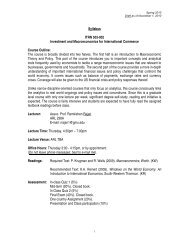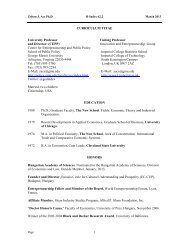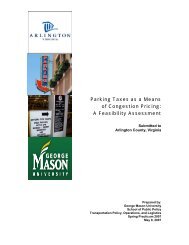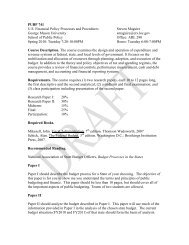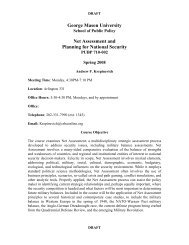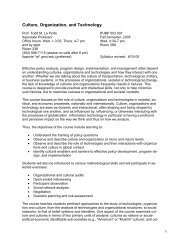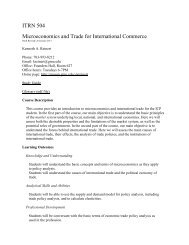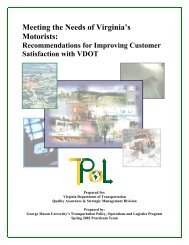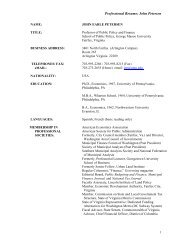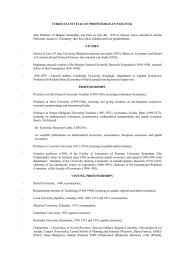Cost Benefit Analysis of Washington-Richmond High-Speed Rail
Cost Benefit Analysis of Washington-Richmond High-Speed Rail
Cost Benefit Analysis of Washington-Richmond High-Speed Rail
You also want an ePaper? Increase the reach of your titles
YUMPU automatically turns print PDFs into web optimized ePapers that Google loves.
<strong>Cost</strong> <strong>Benefit</strong> <strong>Analysis</strong> <strong>of</strong> <strong>Washington</strong>-<strong>Richmond</strong> <strong>High</strong>-<strong>Speed</strong> <strong>Rail</strong> Spring 2010<br />
3.4 Environmental Conditions<br />
22<br />
Figure 3-7: On Road Emissions<br />
The National Emissions Inventory (NEI) is developed<br />
every three years by EPA. The NEI is a national<br />
emissions inventory that includes both stationary<br />
and mobile sources that emit hazardous air<br />
pollutants (HAPs). Section 112(b) <strong>of</strong> the Clean Air Act<br />
identifies 188 pollutants as HAPs, which are<br />
generally defined as pollutants that are known or<br />
suspected to cause serious health problems. The NEI<br />
contains emission estimates for major sources,<br />
nonpoint sources, mobile sources, and other sources<br />
which do not fall into these categories.<br />
Onroad mobile sources include “licensed motor<br />
vehicles, including automobiles, trucks, buses, and<br />
motorcycles.”<br />
The orange and red shading on the onroad emissions map indicates levels that are higher than 691,028<br />
pounds <strong>of</strong> emissions per year. Counties and cities in the corridor service area that fall into the high<br />
emissions category, ranging from highest to lowest are Fairfax, Loudoun, and Prince William counties,<br />
<strong>Washington</strong> D.C., and Chesterfield, Hanover, and Henrico counties.<br />
The middle categories are defined as counties and cities that have moderate levels <strong>of</strong> onroad emissions,<br />
ranging from 127,104 to 691,027. Jurisdictions located in the service area and included in this range<br />
from highest to lowest are <strong>Richmond</strong> City, Arlington and Stafford counties, Alexandria City, Spotsylvania,<br />
Fauquier, Westmoreland, Louisa, New Kent counties, Charles City, Essex, Goochland, Culpeper, and King<br />
and Queen counties, and Fairfax City.<br />
The jurisdictions showing the lowest amount <strong>of</strong> onroad emissions located in the corridor study area are<br />
Caroline, King William, Powhatan, and King George counties, Falls Church, Manassas, Manassas Park,<br />
Fredericksburg, and Colonial Heights cities. These areas have onroad emissions that fall into the range <strong>of</strong><br />
zero to 127,103 pounds per year.<br />
Looking more closely at the data, onroad emissions as a percent <strong>of</strong> total emissions tells a different story.<br />
While Charles City falls into the moderate category for total onroad emissions, onroad emissions makes<br />
up 58% <strong>of</strong> the county’s total emissions. The counties <strong>of</strong> Middlesex, Westmoreland, Kind and Queen, and<br />
Loudoun range from 45% - 48% onroad emissions as a percent <strong>of</strong> the total. For jurisdictions that show<br />
more than half or nearly half <strong>of</strong> their onroad emissions as making up total emissions, this could indicate<br />
they simply have less nonpoint emissions sources and should not be used as a gauge in obtaining<br />
emissions reductions until it is fully understood.



